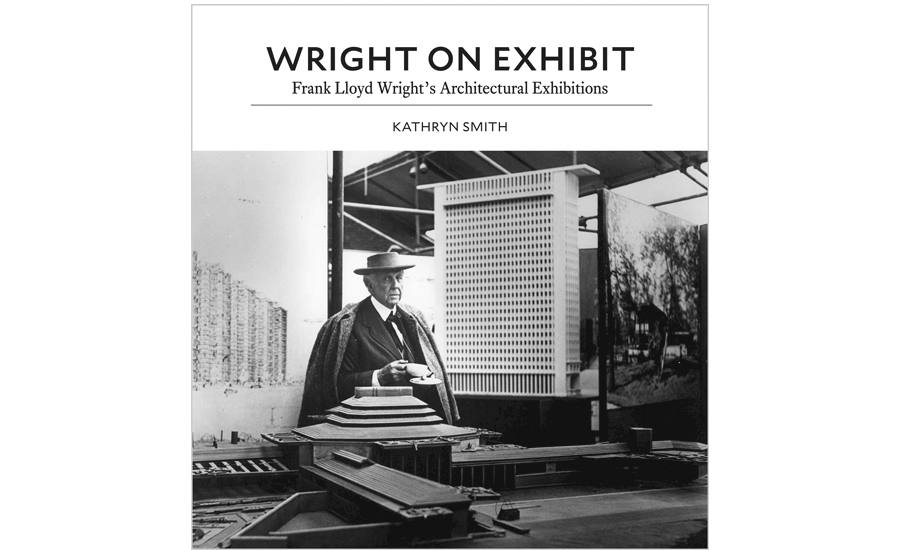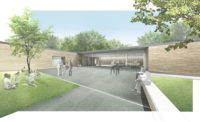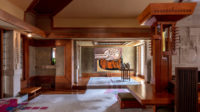Frank Lloyd wright’s 65 years of museum exhibitions during his lifetime produced little surviving evidence in catalogue form—and the domineering manner he brought to the process of putting on a show does much to explain the dearth. Now Kathryn Smith takes us on a comprehensive tour through Wright’s exhibitions, from his first at the Chicago Architectural Club of 1894 to New York’s Metropolitan Museum of Art in 1959. The details are fascinating, especially because of what they tell about the inclusions in those presentations and why they were chosen.
Wright was not content to let curators select or arrange his own work, and he erupted with scabrous objections at their mild efforts to do so. He often provided his own drawings, models, photographs, and text, and at times had a hand in the layout of shows. Accordingly, the impression has emerged of Wright as a cantankerous traveling salesman, arranging his wares to maximize profit. This idea Smith categorically rejects. As she emphasizes, Wright’s museum displays resembled not the advertising pitch but the sermon. He reliably failed to take opportunities to meet museum trustees or other deep-pocketed grandees, and was given to omitting his most popular or venerable works in favor of projects he found more artistically important.
The overall history of his exhibitions, Smith says, reveals “an artist-architect projecting an avant-garde program, an innovator expanding the palette of installation design as technology evolved, and a social activist challenging architectural students and the public with his accompanying lectures and publications.”
The single most discernible trend in the decades of Wright shows was an increased emphasis on the modern qualities of his work with an effort—sometimes accurate, sometimes knavish—to claim credit as the source of inspiration for later modernists. In the early 1930s, Wright began to omit his more conservative or ornamental works from museum shows in favor of schemes he regarded as prototypically modern. His Mostra dell’Opera di Frank Lloyd Wright (often called the “Italian Exhibition”), which opened in 1951 in the Palazzo Strozzi in Florence, featured the Willits House and the Larkin Building, leaving out the better-known Dwight D. Martin and Robie houses. It was part of his consciously self-selective effort to stress emblematically modern developments within his work, such as the unit system, the free plan, and flat-roof buildings.
Smith’s book is a long-needed chronicle of changes in curatorial practice and technology, particularly at New York’s Museum of Modern Art (MoMA), which mounted six solo exhibitions on Wright between 1932 and 1953, and eight others in which he appeared during this time. The architect’s Chicago Architectural Club forays primarily were a showcase for delicate water-colored draftsmanship and small architectural drawings; by 1959 you might find large photomurals, 14 by 20 feet. Wright did not always embrace color in renderings and then photographs: for the expanded version of The Work of Frank Lloyd Wright, 1893– 1930 at the Art Institute of Chicago in 1930, he had early polychrome renderings redrawn as large black-and-white perspectives to show, as Smith points out, “he had anticipated the radical forms of European modernism by decades.”
The book also includes his caustic correspondence, notably with Philip Johnson. After Johnson had come back to MoMA in 1946 to once again act as the director of the department of architecture, he assured Wright he wanted to install a Usonian house in the MoMA garden. But Breuer beat Wright to it in 1949, when his design for a full-scale modern house opened in this setting. Wright wrote: “Phil . . . how could you allow the museum to buy and plug with Usonian language that shanty town version from ‘33rd Street and the tracks’ now in your garden. For Christ’s sake—what a travesty.”
MoMA, judging by its sprawling show, Frank Lloyd Wright at 150: Unpacking the Archive, is clearly fond of its substantial, newly acquired Wright collection, but it may not miss the confrontations it experienced when the master was alive.





Post a comment to this article
Report Abusive Comment